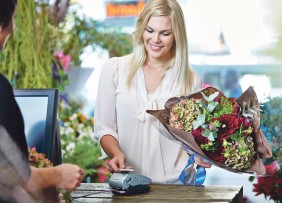Shopping is being redefined as omni-channel as more retailers expand across the internet into mobile apps and open pop-up shops or traditional stores. As the tectonic plates continue to shift underfoot, the challenge for retailers will be keeping up with the pace of change and creating the sales opportunities to take advantage of a new consumer buying climate.
 Here at The Logic Group, we’ve been keeping close track of the ongoing evolution of the consumer and retail landscape by regularly surveying the UK public to track emerging payments trends and to identify the payments technologies to watch. Using data taken at crucial shopping moments, we’ve mapped out a couple of key directions that retail is moving in.
Here at The Logic Group, we’ve been keeping close track of the ongoing evolution of the consumer and retail landscape by regularly surveying the UK public to track emerging payments trends and to identify the payments technologies to watch. Using data taken at crucial shopping moments, we’ve mapped out a couple of key directions that retail is moving in.
SECURITY TAKES TOP SPOT
In light of a wave of recent data breaches, retailers will need to prioritise their efforts to keep customer data safe and secure, and we expect the debate around security to shift in the future. Retailers will start to prioritise communicating around their safety measures and will make much more noise about the preventative security measures they are taking on behalf of consumers.
We’ve found in our surveys that over half of the consumers we spoke to placed security as more important than any other factor when using new payment methods
This focus on reassuring the general public is needed, as we’ve found in our surveys that over half of the consumers we spoke to placed security as more important than any other factor when using new payment methods. This is reinforced by two thirds of respondents to our most recent survey saying they have concerns about their details being stolen as a result of using new technology.
Given the increased emphasis on security, technologies like tokenisation and point-to-point encryption (P2PE) are set to go mainstream over the next few years. In the case of tokenisation, an alphanumeric code, or token, is substituted in the place of payment data when a transaction is being processed. Information about a consumer’s card and personal details is reduced to a string of numbers and letters, indecipherable to any fraudsters who have gained the data via nefarious means. Similarly, for P2PE, consumer card data is scrambled and locked away to boost security. Should a breach occur where a retailer has P2PE in place, any data criminals gain access to is meaningless and unusable. Therefore the retailer has successfully protected its customers and, in turn, its brand.
 Security is an emotional topic, with consumers concerned about the perceived danger to their data and financial details, but also fearing intrusion into their personal devices and, as a result, their lives. While in the past many retailers may have presumed that consumers would not appreciate detailed information about their security systems, in years to come we expect to see more and more information being released to reassure potential and current customers. In the same way that Google offers a seal of approval to provide customers with further confidence in shopping online (Google Certified Shop), easy-to-understand security standards may emerge that offer the same shopper reassurance across many channels. Think of it as a kite mark for secure payments.
Security is an emotional topic, with consumers concerned about the perceived danger to their data and financial details, but also fearing intrusion into their personal devices and, as a result, their lives. While in the past many retailers may have presumed that consumers would not appreciate detailed information about their security systems, in years to come we expect to see more and more information being released to reassure potential and current customers. In the same way that Google offers a seal of approval to provide customers with further confidence in shopping online (Google Certified Shop), easy-to-understand security standards may emerge that offer the same shopper reassurance across many channels. Think of it as a kite mark for secure payments.
SEAMLESS BUYING EXPERIENCE
The concept of omni-channel shopping has been gaining momentum in the industry for some time and we feel it has come to define the future of the retail industry, as it has moved from an interesting new development in convenient shopping to become a customer expectation. As it has become a retail norm, the next differentiator for retailers will be how wisely they use the insight they are receiving on their customers’ omni-channel habits. Expectation will grow on the customer’s side for speedier deliveries, smarter location-based offers and even targeted offers. Retailers with a store heritage, playing on a more equal playing field against their pure-play internet challengers, have everything to gain from seizing the opportunities afforded by the omni-channel.
The advent of omni-channel will not just impact on the way consumers interact with retail brands, but could also help to reshape our high streets as well.
